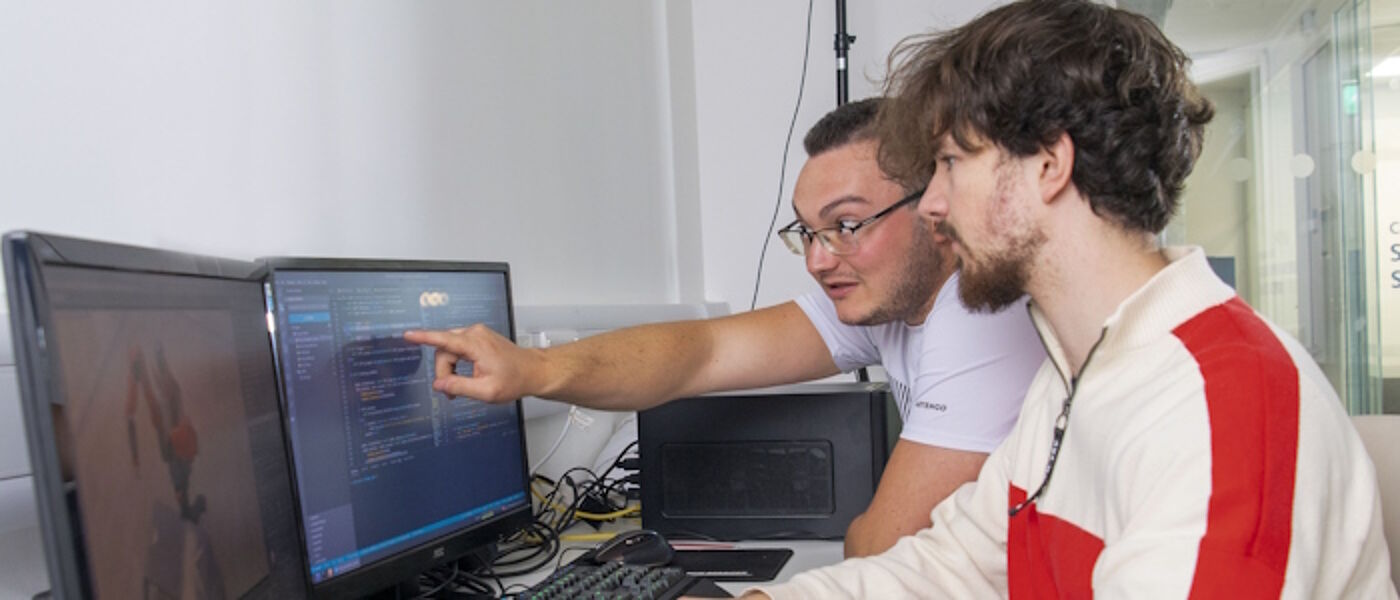
Delivering and Supporting Change
Projects
Below you will find useful information you may want to consider when you are working on your next project.
From guidance on planning your project to managing stakeholders and reflection once it's complete in Running Projects Remotely; information on dependencies, risks and task prioritisation in Managing Workload; to introductions in new change practices, including Scrum, Scalable Agile, Lean and Kanban in Modern Methodologies and Frameworks, there will information worth considering for your next project, large or small.
Running Projects Remotely
 Running Projects Remotely
Running Projects Remotely
It may feel that managing a project remotely is a more difficult proposition from managing one face-to-face, however, there is no reason it can’t be just as successful. There are principles that can be adhered to manage a project while staff aren’t co-located to make projects easier to deliver.
![]()
Having a clear plan is essential to running an effective project. It centrally stores all of the underlying tasks and activities that need to be done, as well as capturing who is responsible for doing them. It can then be used to monitor and track progress of the project itself and easily show whether it is on or off course.
A well written plan not only provides visibility of a project’s progress for any potential reporting lines, it also ensures that colleagues working on the project itself know what they need to do and when they need to do it by. This gives colleagues the opportunity to manage their own workload whilst retaining control over what activity is being done.
Try short term planning for activity over a period of a few days or weeks. It allows tasks to be broken down into manageable chunks ensuring that there’s an immediacy to the work being undertaken. Assigning owners to each of the task spreads the responsibility for their delivery across the members of the team and gets buy-in from contributing colleagues helping to push the project in the right direction.
Whilst short term planning can be useful it is important not to lose sight of the overall objective of a project, especially one which may take a few months or longer to deliver. Keeping a close eye on the activity being planned and relating it to the bigger picture will ensure overall deliverables continue to be met.
![]()
Whether it be the planning of a project or getting through some of the project tasks themselves, collaborating with your colleagues can be a great way to get the job done. We all have different knowledge and experience so why not draw on that. Not only will it ensure that tasks are approached in a more rounded manner it also gives transparency across the team to some of the underlying plans or activity.
There are online workshop tools available that provide an excellent space to collaborate remotely. These are virtual whiteboards where ideas can be formulated and documented, and all participants can contribute live at the same time. We can also set up video conferences on Zoom and MS Teams and share our screens if work has been carried out which we want to present to our colleagues for review and feedback.
![]()
Centrally storing documentation is incredibly important, especially when working remotely. It allows anyone on the project to get access to any key documentation that they may need or make updates to any shared files. There’s nothing worse than needing something urgently from a colleague you can’t get a hold of when you know it’s stored in a folder that only they have access to.
Having dedicated and clearly labelled storage space on MS Teams or Sharepoint is the perfect place to store project documentation. It’s good practice for shared space to be set up at the beginning of a project as it sets standards from the start where colleagues are expected to save or get access to any shared documentation.
![]()
Vital to any successful project is ensuring that the lines of communication remain open. This is especially true when project teams are not co-located or are working remotely.
When running a project, ensuring that important information is shared provides clarity to colleagues on any developments that may impact their contribution towards the project. It also means that colleagues can provide an update on the progress or completion of any tasks.
Meeting on a regular basis is a great way to check in and manage the progress of a project. Daily stand-ups or check-ins are a great start to the day as they allow the project team to have a touch point with their colleagues on the project and have an open discussion on what they have managed to complete the day before and what activity they have planned for the day. They don’t need to last long, 15 minutes or so is plenty. If longer meetings are required these can be scheduled as and when the need arises.
Setting up shared spaces on MS Teams provides a platform for information to be shared and questions to be raised. Rather than having to wait until the next regular meeting to raise an issue it can be easily communicated and discussed on a Teams board for everyone to see. It ensures that communication remains speedy and transparent.
![]()
Managing stakeholders can be more difficult when working remotely, but it is still important.
Continue to have regular meetings online via video conferencing as it allows both team members and stakeholders to see each other improving the feeling of connection. Encourage attendees to pitch in with their updates and ideas as this will help create an atmosphere where everyone feels comfortable contributing.
If there are any issues that perhaps are better being discussed in a smaller group set aside some time for them to be resolved. Again, video conferencing is valuable as visual cues are important and can make compromise more attainable. Try and avoid lengthy email chains which can sometime be misconstrued.
A weekly newsletter can be a good way to keep stakeholders engaged. It doesn’t need to be anything particularly advanced, simply providing teams with some key information about the progress being made and bringing potentially important issues to the fore will suffice. It’s a short snappy way to get your message across.
![]()
An important quality to have when you are managing projects remotely is trust. Trust that your colleagues will undertake the activity that they have been tasked to complete.
Staff may have other responsibilities in their roles or personal lives that they have to take care of and so cannot solely work on the project activity as an absolute priority, as such it is necessary to trust that they will be able to manage their workload accordingly in order to get what they need to do done.
If trust is given it helps build an effective relationship so if someone were struggling to complete a certain task on time they would feel more comfortable saying so, allowing mitigating action to be taken.
![]()
It’s important to take time to reflect on a project or phase of a project when it is over as there are valuable lessons that can be learned for any future activity. Holding a Retrospective or setting aside time to run through what went well and what didn’t, will ensure that improvements can be made where needed.
The same tools that were used to collaborate remotely can be used to conduct retrospectives where each member of the project is able to openly share what they felt about that work that has just been undertaken.
Managing Workload
 Managing Workload
Managing Workload
Dependencies and Risks
Dependencies
A dependency is the relationship that defines the order in which tasks within a project or process are carried out. Task A is dependent on Task B if the start or finish date of . Knowing that dependencies exist is the first step to being able to manage them, and vital for making sure that project outcomes deliver on time. It is particularly important to understand where they fall if they are out with your control – whether within another team, department or supplier. These are the dependencies that have the greatest possibility of presenting a risk to your work.
There are several different ways of thinking about dependencies. The easiest way is to think of the impact on your project timeline, or on your features or stories within an agile sprint. For example, if you were building an app, you may be reliant on another project’s completion in order to reuse the specialist code they were creating. In this situation, there is a risk that their work doesn’t finish on time or that the code isn’t reusable after all and you have to start from scratch (adding time and cost to your project).
Using a Kanban board or planning software like Jira, you can indicate where they dependencies on your work may fall, to drive greater awareness, engagement and control. In the case of using an agile approach to projects, it is incumbent on the team’s Scrum Master to ensure that the team continuously address and manage their dependencies.
Now that you know what your dependencies are and the areas that they affect, you need to consider the risks they present to the project. It is important that each dependency is considered, and the team works out (with stakeholder input) what the risk may be. The biggest single thing you can do to help address the risks caused by dependencies is to talk to people.
Risks
It is vital that risks are fully considered and managed within the context of projects. To understand how risk can be mitigated, it is helpful to consider how risks may occur in the first place. Risk can be driven at a project level by:
- Incomplete requirements
- Lack of communication. Teams and Users are not involved
- Incomplete effort
- Unrealistic stakeholder expectations
- A lack of planning at the organisational level and project level
- No commitment to the combined goal
- Complicated business or technical architecture
Risk can also be at an enterprise or organisation level:
- Financial risk - can we afford to pay for it?
- Business risk - will it be used? Does it solve the problem?
- Technical risk - can it be made/build? (this is often in relation with finance, when a product or service is possible to build, but too expensive).
Risks should be surfaced and then assessed. A handy tool to use is the Probability v Impact model, but many organisations have their own risk model to refer to.
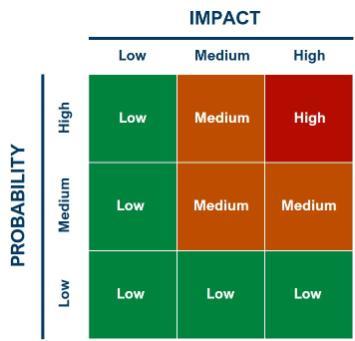
Risks can be placed on the matrix and classified. Importantly, mitigating actions need to be developed for each risk, and in the case of operating in an agile environment, these actions need to appear on the project backlog, and prioritised for sprint delivery according to their classified severity. For example, in the case of a risk around available resources of subject matter experts to complete a task, a mitigating action may be a workshop with these stakeholders to work through how this may be resolved collaboratively.
Agile emphasises that risk in projects should be dealt with continuously, rather than simply appearing on a risk log for consideration by governance layers. The best way to reduce risk in general is to deliver value incrementally.
Task Prioritisation
Being able to prioritise tasks is vital to ensuring you and your team know where to focus efforts. There are many techniques and tools to help you do this. A commonly used scale for attributing a priority is known as the MoSCoW method – determining whether a task ‘Must’ be done, ‘Should’ be done, ‘Could’ be done or ‘Won’t’ be done (for the time being).
The categories can be broken down into the following simple terms.
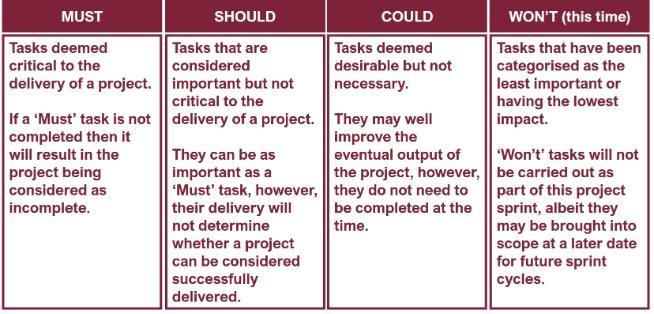
When attributing a priority it is important that these are ratified by the project’s stakeholders. A task that you deem as important may not have the same value assigned to is as the stakeholders and vice versa. Getting stakeholders to agree to the priority helps set accountability for the work due to be undertaken and allows focus to be placed where it is deemed most necessary.
There is a tendency too to capture everything as a Must, as such it is prudent to set some rules when defining priorities otherwise real task prioritisation will not happen. For example, you may wish to put a limit on the amount of Must tasks the project will have, that way it will encourage critical thinking as to exactly what is needed.
Project deliverables can of course change from time to time so it is worth noting that prioritisations can be revisited and reassigned. Again, getting ratification from stakeholders ensures that everyone involved is on the same page.
Modern Methodologies and Frameworks
 Modern Methodologies and Frameworks
Modern Methodologies and Frameworks
A commitment to modern ways of working often means adopting new approaches, practices or frameworks to improve how projects are initiated, planned and delivered. An overview of some of the most popular ones are here. Get in touch if you’d like us to provide information on others you may have heard of.
Scrum
Much like a rugby team (where it gets its name), Scrum is a framework that helps teams work together. Scrum teams learn through their experiences, they self-organise while working on a problem, and reflect on their deliverables and activities to make sure that they continuously improve.
Scrum has 5 key values. These are:

Scrum is often thought of as an agile project management framework, and describes a set of meetings, tools, and roles that work together to help teams structure and manage their work. It acknowledges that team members don’t know everything at the start of a project and will evolve through experience. Scrum is structured to help teams naturally adapt to changing conditions and user requirements. Re-prioritisation is built into the approach, as are short development cycles. While Scrum is structured, it is not entirely rigid. Its execution can be tailored to the needs of any organisation.
Key components of Scrum include Roles (eg Scrum Master), Events (eg Sprint Planning), Artifacts (eg the Sprint Backlog).
Modern Ways of Working has more information about some of these components on our Agile pages, or you can find out more at Scrum.org
Scalable Agile Framework (SAFe®️)
While Scrum is a framework based on Agile values, SAFe®️ is a scaling framework that implements Scrum at an enterprise level. In other words, Scrum is basically used to organise small teams, while SAFe®️ is used to organise the whole organisation. Both Scrum and SAFe®️ function under Agile principles, but there are key differences between the frameworks:
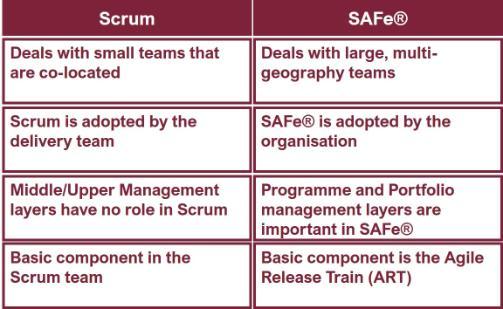
The principles of SAFe®️) are:
- Take an economic view
- Apply systems thinking
- Assume variability; preserve options
- Build incrementally with fast integrated learning cycles
- Base milestones on objective evaluation of working systems
- Visualise and limit work-in-progress, reduce batch sizes, and manage queue lengths
- Apply cadence (timing), synchronise planning
- Unlock the intrinsic motivation of knowledge workers
- Decentralise decision-making
- Organise around value
SAFe®️ utilises Epics, Features and Stories to split and organise workload across the portfolio, makes use of synchronous planning to tackle dependencies and risks, and to ensure full transparency and visibility of the work.
Find out more about the SAFe®️ framework.
Lean
Lean originated in the middle of the 20th century in Japan. It was invented by the managers of the Toyota Corporation. Their initial goal was to create a system of manufacturing that solves their problems with product delivery. Initially it was called Toyota production system. It became famous throughout the world, and the approach was adopted by other organisations attempting to improve productivity.
Lean is about improving flow and minimising waste. A lean organisation understands customer or user value and focuses its key processes to continuously increase it.
The basic principles of Lean are:
- Focus on effectively delivering value to your Customer
- Respect and engage the people
- Improve the Value Stream by eliminating all types of waste
- Maintain Flow
- Pull Through the System
- Strive for Perfection
Lean thinking changes the focus of management from optimising separate technologies, assets, and vertical departments to optimising the flow of products and services through entire “value streams” that flow horizontally across technologies, assets, and departments to customers or users. Eliminating waste along entire value streams, instead of at isolated points, creates processes that need less human effort, less space, less capital, and less time to make products and services at far less costs and with much fewer defects, compared with traditional business systems.
Value streams are improved by following the Plan-Do-Check-Act process. By creating an environment of safety and order, you can more easily identify where waste happens.
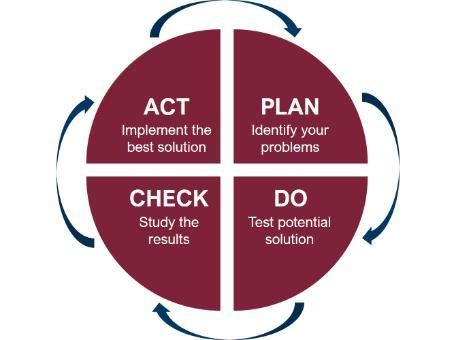
Lean is often used to improved organisational processes that are inefficient. Find out more about Lean and how it is used in project management.
Kanban
Kanban is a visual system for managing work as it moves through development. Kanban visualizes both the process (the workflow) and the actual work passing through. The goal of Kanban is to identify potential bottlenecks in your process and fix them so work can flow through it cost-effectively at an optimal speed or throughput.
Lack of efficiency is a problem experienced by project teams. Most of the time, the issue lies in having no clear insight into what the team is doing and what exactly is dragging the productivity down. Adopting Kanban can turn the tide around and help you become more efficient than you ever were by revealing where exactly the team needs to start improving.
Kanban (in English: signboard) started as a visual scheduling system and, like Lean, originates from the Toyota production system. A few decades later the idea was further developed by David Anderson, who formulated the Kanban method and introduced the Kanban board.
Key approaches adopted by Kanban include:
Visualise the flow of work
This is the first step to adopting and implementing the Kanban Method. You need to visualize – either on a physical board or digitally, the process steps that you currently use to deliver your work. The Kanban board can be very simple (for example ‘To Do’, ‘Doing’ and ‘Done’), to very elaborate. The work can then be visualised within the process steps or ‘columns’ in the form of coloured post-its or cards with different colours to signify either different classes or types of work items. If you think it may be useful, your Kanban board can also have different Swim Lanes, one for each class of service or for each work item type. However, initially, to keep things simple, you could also just have a single swimlane to manage all your work – and do any board redesign later.
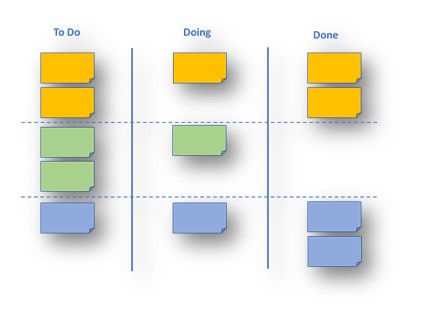
Limit Work-in-Progress (WIP)
The aim is to restrict the maximum number of tasks in the different stages of the workflow. Limiting WIP allows you to finish work items faster, by helping your team to focus only on current tasks. This can be done by imposing WIP limits for each of the columns. For example, you may decide that the ‘Doing’ column should have no more than 6 items underway. This focuses effort on completing the items so that more can be ‘pulled’ from the ‘To Do’ column.
Manage Flow
Kanban can help highlight the stages and status of work, and where work maybe piling up as things get held up and start to hold up capacity. The visual system helps the team analyse what might be going on, and so tackle the bottleneck areas. It may be helpful to introduce a ‘Blocked’ column to demonstrate where work is held up. Over time, this will help the team start to understand their ‘cycle time’, making their work more predictable and manageable.
Make process/workstage processes explicit
Use your board to educate your stakeholders on the complexities and necessities of the activities on your board. For example, web content should be checked to ensure it works with assistive technologies for maximum accessibility. If this is explicit on the board within a column, stakeholders will begin to understand the process and value the output.
Use Feedback Loops
Feedback loops are an integral part of any good system. The Kanban Method encourages and helps you implement feedback loops of various kinds – review stages in your Kanban board workflow, metrics and reports and a range of visual cues that provide you continuous feedback on work progress. Getting feedback early, especially if you are on the wrong track with your work, is crucial to delivering the right work in the shortest possible time.
Many teams make use of Kanban boards, even if they are using other Agile approaches such as Scrum, whether a physical whiteboard, or via tools such as MS Planner, Trello or Jira.
Find out more about the Kanban method.
People
People make a project. They are fundamental to successfully delivering change.
Should you wish to know more about running remote meetings and workshops in Connecting and Collaborating Remotely; the benefits of being 'T'-shaped and how to develop a 'T'-shaped culture in Building 'T' Shaped People; feedback loops and developing working practices in Developing Organisational Agility; and what Our Change Community does and how to get involved, have a look at the information below.
Connecting and Collaborating Remotely
 Connecting and Collaborating Remotely
Connecting and Collaborating Remotely
Running remote meetings and workshops
Meetings and workshops remain a fundamental way to connect and collaborate with our colleagues, even when working remotely. They may be facilitated in a slightly different way but should be no less effective as they would be if we were on campus. How can we continue to get the best out of these interactions? Let's find out.
Meetings
Video conference calls can replace face-to-face meetings. Here’s a few best practice tips when conducting conference calls.
![]()
When you set up a meeting make sure the link for the meetings is included in the invite, that way attendees only need to open the calendar invite to retrieve the link rather than having to look through their inbox for the correct dial in information.
You can configure Outlook so that Zoom is included in your Add Ons, that way it is only a click away when you are sending out your invite. Glasgow Anywhere has instructions on how to add this.
![]()
Other than the obvious, meeting online is no different from meeting in person. Be clear on the subject line of any invites what the meeting is for, that way when it is received your colleagues will know exactly what they have been asked to attend and why.
Set an agenda and pull together any papers in advance of the meeting and circulate these, if appropriate, preferably in the invite itself before the meeting to ensure attendees know what the meeting is hoping to achieve and how the session will be broken down.
In the meeting itself continue to capture actions or decisions like you normally would. If you don’t have a central log stored like MS Teams or Sharepoint where this information is stored, it is worth sending round a communication once the meeting is over with a recap to ensure everyone has a shared understanding of the outcome and any resulting activity.
![]()
Every effort should be made to attend remote meetings on time. It is arguably more disruptive to become a late attendee at a remote meeting. If you are held up or won’t be able to make the meeting at all, drop a line to the organiser to let them know.
![]()
It’s trickier spotting the physical cues we normally display when we want to say something when we are meeting face-to-face. Depending on the size of the remote meeting we may still be able to see these cues, however, in bigger meetings that may not be possible. We should therefore be mindful to offer colleagues the opportunity to speak up when they want to raise a point.
If you are hosting, this may require pausing what you are saying or intervening in the conversation to present a break that will allow our colleagues to speak up. Conversely, if you are wanting to say something try and avoid interrupting someone when they are in the middle of talking but indicate that you are keen to make a point, this could be saying just by saying words to that effect or using the tools embedded in the application, such as the chat facility or 'raise your hand' function.
There may be times when items being discussed don't necessarily need to be talked through in front of the group. Rather than interrupting the flow of the meeting these can be dealt with separately, perhaps with another video conference with only the key attendees or simply a direct phone call.

Physically showing colleagues what you've been working on can sometimes be the most impactful way to get your point across. Video conferencing facilities have the functionality whereby we can share our desktops or even just a particular item that we want to display. You may have to carry out a presentation online so by sharing your screen and conducting a slide show you can show your colleagues an item as well as talking them through it.
It's worth noting that if you are sharing your desktop you should be mindful of any potentially sensitive material that you would not ordinarily want to share may be on display. To avoid any embarrassing slip-ups you should make sure that you've closed down any items you wouldn't want your colleagues to see before sharing your screen.
There are great tools available that can be used to collaborate online too. Find out more below when we talk about Workshops.
![]()
Video conferencing tools have a chat facility which, although often underused, can be a great way to supplement the conversation. This may be to share links with the group for items being discussed, or logging a question or point you wish to be addressed.
The chat function allows you not only to communicate with all attendees, but contact someone directly where you don't want the message to be broadcast to everyone. It could be that a point being raised on a presentation is particularly pertinent to your area of work. Where we would normally have given a colleague a gently nudge or glance when face-to-face, you can send them a message to let them know.
Workshops
Working remotely certainly makes running workshops a trickier proposition, however, that doesn’t mean they can’t still take place, we just need to adjust the way they are run to get the most out of them. Here are a few useful tips for running workshops remotely:

Getting the technology right in advance will help your workshops to run smoothly, include everyone and manage any risk of software problems taking your agenda off track.
Decide which tools you will need to run your workshop or meeting ahead of time. These will vary depending on what your team needs them for, but generally we have found we need:
- an interactive whiteboard
- a video conferencing tool
- a team collaboration tool
- a device with a timer
![]()
Virtual artboards or whiteboards help better engage distributed, remote teams in brainstorming, processes, workshops and decision making with digital workspaces that enable real-time, multi team member collaboration — just as easily as if everyone were in the same room.
Miro and Mural are whiteboard applications but you can also use the whiteboard on Zoom our even a Google doc.
![]()
Video conferencing facilitates are available through Zoom or MS Teams. Remember online, non-verbal cues are key, so make sure your camera is on and use the application’s full functionality such as the raise hand or thumbs up function or the polling feature.
More information on getting started with Zoom.
![]()
A team collaboration tool, such as MS Teams, should be used as a communication and collaboration platform. Used correctly, they provide the perfect platform to coordinate workload and stay connected.
MS Teams integrate with a number of applications, provides an instant messaging feature and file storage.
![]()
It helps to time box (define the period of time by which you would like a task completed), to help focus activities. To do this you can use any device with a timer and alarm – such as a mobile phone. You could also use an online version such as Tomato Timer.
![]()
As well as different software tools, you might also want to think about what hardware you need.
We recommend:
- a laptop with a strong internet connection
- headphones
- test your microphone ahead of time – you might want to use headphones with a built in mic
- a quiet space with limited background noise
![]()
Test access to all technology ahead of time, especially if you are inviting people outside your team. As far as possible, try to have a backup plan where for anyone who struggle with technology.
Make sure all links are in the meeting invite, and if people need to sign up for certain tools head of time, send them a reminder a few days before.
If you need help running your first remote session get in touch.
Building 'T' Shaped People
 Building 'T' Shaped People
Building 'T' Shaped People
What is a ‘T-shaped’ person?
T-shaped people have capabilities in many areas and are experts in at least one. They have a broad base of experience to draw upon and are willing and able to ‘roll their sleeves up’ and provide support to other team members and colleagues.
The exact capabilities will (and should) vary from person to person. Indeed, as you start out in your career you may find that your knowledge and skillset look more like an ‘I’ – a specialist with little generalised knowledge. Or perhaps at a point in your career, you’re more of a dash ‘-‘. Lots of generalised knowledge but no real depth in any one area.
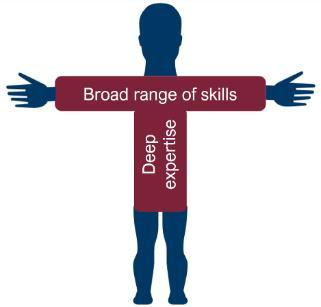
Benefits of being ‘T-shaped’
The commitment to being ‘t-shaped’ supports modern individual and organisational agility – being able to respond quickly to external and internal changes in context. In particular, a focus on developing skills in this way will deliver the following benefits:
Commitment and Focus - When you focus on just one area, it can get monotonous. No matter how fascinating the topic, variety is key to keeping your mind engaged. As a T-shaped person, you always have other areas to dip into when you need a break from your specialty.
Even as you get to move around to different areas to avoid getting bored, you also get to experience the satisfaction that comes from diving deep in one subject area. The deeper you go, the more you realize how vast your area of knowledge is and how there’s a lifetime of learning ahead.
Creativity - There’s a classic idea in the arts (and in business) that the greatest ideas happen at the intersection of disciplines. With a broad base of knowledge, you start to see the links between concepts and the possibilities and opportunities. T-shaped people tend to have a more holistic approach to problem solving.
Collaboration - Because you have a broad range of knowledge, you know just enough to communicate with specialists in different fields. This makes collaboration much easier.
Building Organisational Talent - It is in everyone’s best interest to weave growth, learning and sharing into the company culture. It creates a more positive, more dynamic and attractive culture.
How to develop yourself as a T-shaped person
In developing yourself as a T-shaped person, the first questions to address are What skills should I build? What should I learn?
First, you need to assess what skills and knowledge you already have, and then honestly rate your ability in each area. This helps assess where you want to improve your capabilities, what ones you want to add, where you are comfortable simply maintaining specific skills, and where it may be best to develop more depth.
We’ve developed a handy tool, to help with your assessment - Capability Review Tool
It is worth bearing in mind some principles when choosing what to learn:
Remember to mix both hard and soft skills - In addition to hard skills, such as design or programming skills, T-shaped employees also possess soft skills such as networking and critical thinking, making them a complete package.
Don’t let your ‘expert’ area limit you - It’s easiest to consider developing knowledge on the periphery of your deep skillset, however often your area of specialism may feel limiting, especially if it’s something you’ve been doing for a long time. The thinking patterns and working practices you have developed may be just as applicable to a topic that sits well beyond your usual boundaries.
Focus on what interests you - There are areas that everyone would benefit from knowing about – for example presentation or analytical skills, however you should focus first and foremost on what interests you. If you pick up something that really fascinates you, this is what will get you through more difficult learning periods where making progress is hard.
Read across a variety of subjects - One base area that everyone can benefit from is being “well-read”. This builds the habit of intellectual curiosity and challenging your ideas. Read whatever interests you and read across a range of areas. This will inspire you to consider new areas of development.
Developing a T-shaped culture
Developing T-shaped people is a long-term commitment and requires a strong understanding of both the person and their position in the organisation.
A valuable place to start is to consider adjacent activities to those within the realm of the considered role - that is, through the lens of workflow, at any point where one role is handing off to another. Another place to start is to consider cross-training on similar skills – for example an alternative, but similar, organisational system or technology.
Training gaps can be identified through mapping key person dependencies. By using a ‘pairing’ approach – matching two individuals up - co-development can take place, as well as the key person risk mitigated.
Culturally, it makes sense where possible to de-emphasise specialisation where possible, focusing on shared endeavours and encouraging more collaborative working practices. The ‘role not job’ based approach of Agile teams are an example of this.
Practical tips
What does a commitment to T-shaped look like on a daily basis? The following are handy approaches to bear in mind:
Make it a habit - Whether developing skills for yourself, or supporting them for others, it needs to retain focus. Adding it to a daily ‘to-do’ list, or backlog definitely helps. Using techniques such as Kanban helps keeps track of progress too.
Work on a variety of projects - Exposure to the ‘new’ is key in identifying novel, helpful capabilities. However, the comfort of being able to operate within a familiar context supports confidence levels and mental wellbeing. Working on a mix of activities or projects will develop new skills whilst maintaining appropriate balance.
Regularly evaluate progress - Continuous improvement means regularly assessing progress. Here are a couple of self-evaluation ideas:
- Test a particular knowledge area by reading a paper/article and self-rate understanding of the topic from 1-5 to expose knowledge gaps.
- Teach skills to someone else. This has immediate feedback and will expose areas that are weaker.
Give your speciality extra attention - It is often the case for some that new learning may be a welcome distraction from your depth area of skill or knowledge. However, you need to pay special attention to your speciality. It may be worth referring to a source such as the Dreyfus Model and see where you fall on the scale from Novice to Expert. Also, seek out a mentor who can help you retain focus and provide feedback.
Deconstruct skills - Pitching new areas of interest at too high a level can make them feel unachievable, and often overwhelming. For example, ‘learning new computer skills’ is a huge, vague goal. Unless this can be made more concrete, it will overwhelm and interest will be lost. Breaking the skill down into component parts – for example ‘learning about MS365 tools’ – makes the new skill much more achievable. In addition, setting SMART (specific, measurable, achievable, relevant, time-bound) objectives for the area of study, will ensure motivation to complete and move on to the adjacent components.
Developing Organisational Agility
 Developing Organisational Agility
Developing Organisational Agility
Introduction to Organisational Agility
Organisational agility is the ability of an organisation to renew itself, adapt, change quickly, and be successful in a rapidly changing, ambiguous, turbulent environment. Agility is not erratic, nor incompatible with stability. Indeed, agility requires both stability and long-term commitment.
Organisational agility is a core differentiator, and most would observe, a necessity in today's modern working world. Organisations should be agile enough to anticipate fundamental marketplace and environmental shifts and reshape their priorities rapidly in response.
Agility needs two things. One is a dynamic capability, or the ability to move fast. To deliver and drive the organisation at speed with nimbleness and responsiveness. However, agility also requires stability, a stable foundation of things that are consistent and trusted – such as policies or design principles. This stable backstop becomes an anchor point that doesn’t change while many other things can change continuously.
Organisational agility should not be confused with using Agile practice or frameworks, although most organisations seeking to improve their ability to respond quickly, adopt these practices.
Developing Organisational Agility
Some high-level approaches to developing Organisational Agility include:
Set an actionable strategy that you can translate easily
- Build a case for change that is based on user needs, is recognisable to the organisation and has the support and commitment of the senior team
- Create a vision that looks outwards beyond the turbulence of today’s world and takes inspiration from tomorrow
- Co-create a roadmap that demonstrates how the strategy will translate into activities or deliverables for employees, users and stakeholders
- Create the capacity and capability needed for change – develop new skillsets and encourage a ‘T-shaped’ culture
- Communicate the vision and the roadmap clearly, regularly and consistently. A vacuum of information is dangerous and unsettling
Encourage the new and (when you can) retire the old
- Make sure your direction is informed by what users need, want and expect from processes, products and services
- Establish service design as a way of improving innovation and gaining trust
- Plan to deliver business change that will wrap the organisation around the new elements and (when you can) purposefully retire the old
Put humans at the heart of the change
- Start small and fix something useful, so that you build energy, enthusiasm and awareness as you go
- Use Agile to embed small and frequent releases (of technology and business change) eliminating the drama of slow, high pressure, big-bang delivery
- Be transparent and build a culture that listens and continuous improvement through the use of communities and feedback loops (read on for more information on these)
- ‘Show and tell’ strong, relevant delivery and feed the appetite to do more
Make Decisions with Data
- Take a holistic, or systems-based view that uses multiple data sources and relevant insight to respond to both internal challenge and external opportunity
- Delegate responsibility as far as possible, engender autonomy and support leaders and teams to build local capability and embed new ways of working
- Review existing governance arrangements so that you get assurance of the right deliverables and direction through visible, tangible change
Feedback Loops
Tuning into the culture - the thoughts, feelings and actions of people - is vital when developing organisational agility. It helps create a collective understanding of how the institution operates to design and deliver change more effectively. Feedback loops are a great technique to help build a robust and resilient organisation.
What are feedback loops?
Feedback loops provide people with information about their actions in real time, then give them a chance to change those actions, pushing them toward better behaviours. Feedback loops are necessary to monitor success in a complex environment.
For example, understanding how teams are using collaboration software everyday. It's useful to understand if the technology is fit for purpose and if there is anything further that the teams could use to be of more value.
Why do we need feedback loops?
Feedback loops are necessary to monitor success in a complex environment. They help organisations, teams, individuals and communities to assess how they are working and adapt to make improvements.
How can I create feedback loops across teams?
We recommend four ways to help you get started as you design, develop and maintain your working practices to incorporate sustainable feedback loops which you can develop as your approach matures.
These are:
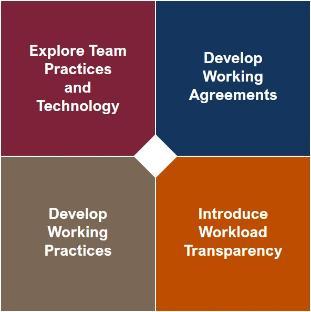
Explore Team Practices and Technology
Setting your team up for success starts with giving them all the tools and technology they need to do their job well. Working without the functionality to support this way of working increases the risk of duplication of effort costing organisations time, money and morale.
There are a number of things to consider when you are setting up the right tools and technology to support your team.
We recommend you run a hands-on session with the team and assess:
- What problems your team are trying to overcome?
- What current solutions you have and how they are performing?
- What budget may be required to get the tech you need?
- What practices or tasks do the team need to be able to carry out?
- What metrics are available on the performance of current tools and what metrics might any new ones give us that we are missing?
- Who needs to approve/sign off the use of new tools?
- How will we test the performance of any new tools and how will we get feedback from users?
- What risks and security procedures might we have to consider and who can help us understand and overcome them?
If you need help running an interactive session to help your team explore their practices and technology requirements get in touch.
Develop Working Agreements
Developing a working agreement is a helpful approach for teams to organise and align their workload and get on the same page. It can help resolve conflict and build a productive culture of shared values and robust working practices.
If you need help running an interactive session to help your team develop their working agreements get in touch.
Develop Working Practices
What are Working Practices?
Working practices are agreed upon methods used by a team to outline how they perform tasks.
This might cover areas such as:
- how the team runs planning sessions
- how the team reflect on the work they have done
- how the team celebrate success
- how the team treat each other
- which tools and technology the team use
- how team communications will work
If you are a new team, or if you are about to start a new project, or getting used to a new working environment, you might want to hit the reset button on your current working practices in order to review how your team works.
If you need help running an interactive session to help your team getting set up with new working practices get in touch.
Introduce Workload Transparency
Why is transparency important?
Transparency fosters trust, improves employee engagement and helps teams and individuals develop a shared understanding of the work that is being done. It helps the visibility of project goals, roles and responsibilities and gives everyone oversight of the strategic objectives involved in delivery work. Transparency is key when working in Agile.
It can also help reduce:
- duplication of effort costing organisations time, money and morale
- senior managers missing out on the vital feedback loops necessary to ensure organisational change
- poorly reflected team metrics, as re-work is more likely
How do I create a transparent workload?
We suggest your team consider getting started with a product backlog and don’t be shy about sharing it with other people and teams if they are interested. Make sure there is visibility of all the tasks your team are working on, which member of the team is working on it, and the status of its completion.
If you need help running an interactive session to help your team introduce workload transparency get in touch.
Our Change Community
 Our Change Community
Our Change Community
Developing a Change Network and how far we’ve come
As the University embarked on an ambitious transformation programme, a Change Network was created as an approach to embed and sustain change within the institution. The network of enthusiastic and motivated volunteers provide a channel to help inform, engage and listen to the people of the University. In just under two years the Network has grown from a handful of colleagues to over four hundred change ambassadors. Each college and job family are represented, in a community who believe in and want change.
The expanding Change Network allows colleagues to meet up at larger events, attend interactive workshops and help shape change through valuable feedback.
What does the future of the Change Network look like?
How our Network can become a Community of Practice
Our Network has advanced from a small number of people doing things together, building momentum and opportunities for success, to a centre of strength, which if connected with other communities, can create an extraordinary movement.
Benefits of our Change Network
As a collective group of connected and engaged change ambassadors we can enhance the value and benefits our Network brings to the University as well as recognising the value we gain as a member of the Network.
Benefits for the University:
- A motivated and engaged staff network, committed and actively involved in change
- Staff who have a better understanding of the University's strategy and forward thinking
- A Network that shares skills and knowledge and therefore improving staff experience
Benefits for the change ambassadors:
- Connection to a professional network of colleagues
- Active involvement in shaping the University of the future
- Learning new skills and gaining knowledge through collaboration with other Network members and professional experts
How can you get involved?
Join the UofG Change Network and connect with hundreds of your colleagues to get involved in what is going on.
Already one of our Change Ambassadors? Actively encourage colleagues and team members to join you in the Network, creating a powerful voice within the University community.
Participate in a full range of events exclusively available to Change Network members. Learn new skills, build capabilities and knowledge on Change and help shape our University community through collaborative workshops, online webinars and even external speakers.
Get in touch if you have any ideas to help develop the Change Network.

